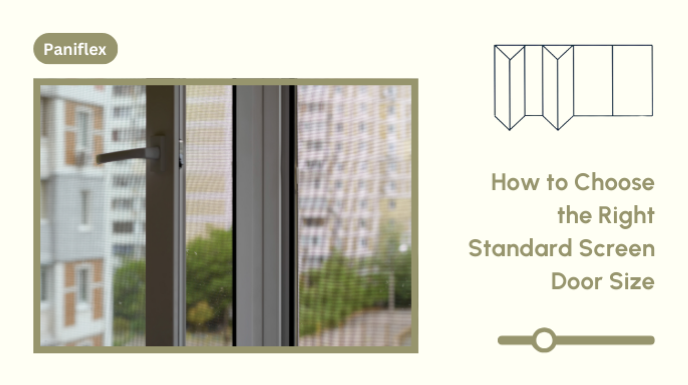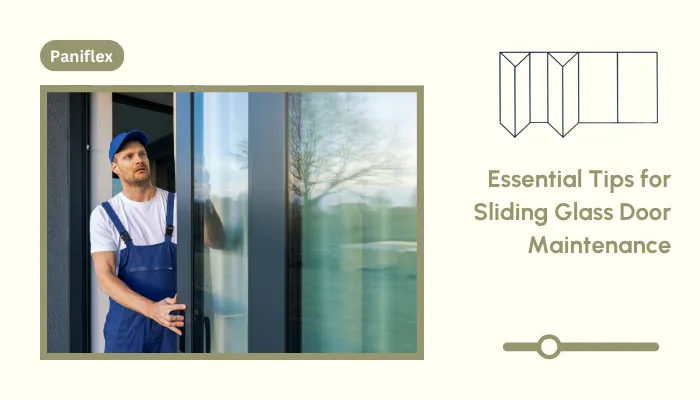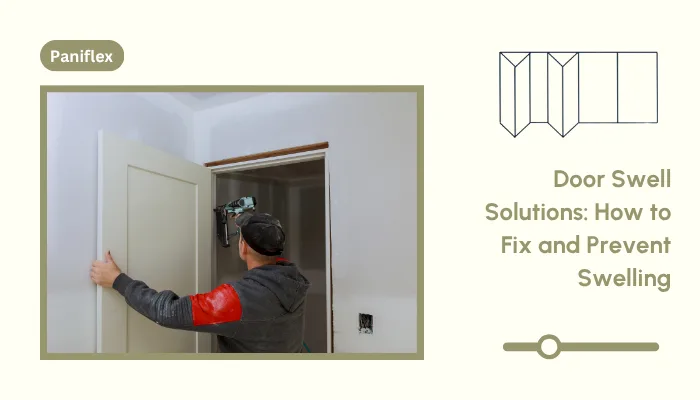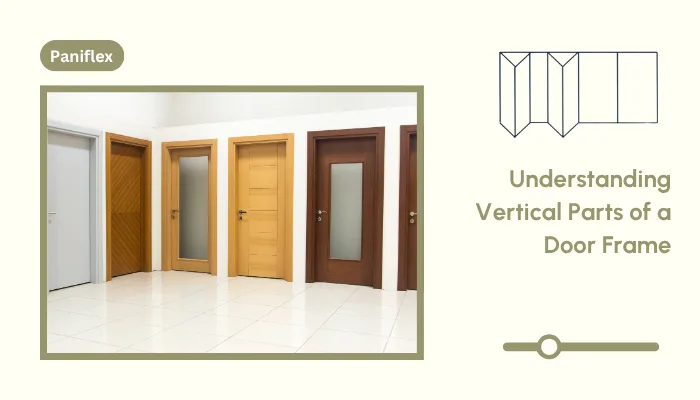Have you ever found a screen door that perfectly fits your home, only to realize it’s either too small or too large for your doorway?
This common frustration often leads to wasted time, extra expenses, and a less-than-ideal fit that compromises your home’s aesthetics and functionality.
Ready to experience the benefits of custom closet doors? Explore our range of Paniflex products now.
Choosing the right screen door size is not just about getting the measurements right; it’s about creating a seamless integration that enhances your living space, keeps pests out, improves insulation, and simplifies installation.
Let’s explore the steps and considerations to help you find your home’s ideal screen door size.
Measuring Your Door Frame for the Perfect Fit
The first step to the right screen door is accurately measuring your door frame. Measuring the door ensures that it fits snugly and operates well. Here’s how to do it:
- Width Measurement: Measure the width of your door frame at three points: top, middle, and bottom. Record the smallest measurement to account for any variations.
- Height Measurement: Measure on the frame’s left, middle, and right sides. Use the smallest measurement for precision.
- Depth Measurement: Measure the frame from the front edge to the back edge to determine the door thickness. This will help ensure the screen door lies flush and snug against the frame, with no open gaps that can allow unwanted insects or air to leak in.
- Allow for Clearance: Deduct a small amount from your measurements to provide clearance, ensuring the door doesn’t scrape or stick. Clearance is particularly important for smooth running and accommodating slight discrepancies in the frame’s shape.
For the most precise results, consider using a metal measuring tape. Take each measurement at least twice, write down the measurements, and label each clearly to make ordering the screen door easier.
If your doorframe has other architectural details, like decorative trim or recessed edges, take those into account by measuring the innermost and outermost parts of the frame. These extra details ensure the door is compatible with your frame design.
These steps ensure your screen door fits perfectly and works as it should.
Paniflex understands that every project is unique. Their custom doors fit seamlessly into your designs and adapt to any existing structure without modification. This allows you to easily maintain your design’s flow while addressing spatial challenges.
Now, let us understand the type of screen doors and their advantages to suit your choice.
Understanding Types of Screen Doors
Screen doors come in different styles to suit various tastes and needs. Each has advantages, depending on your home’s layout and usage requirements.
- Traditional Hinged Screen Doors: They swing open and close like standard doors. They are suitable for front or back entrances and are durable and functional enough for high-traffic areas. Available in many materials and designs, hinged screen doors suit most homeowners’ needs.
- Sliding Screen Doors: These are perfect for patio or sliding glass doors. They move along a track with ease. These are perfect for maximizing space as they do not require a swinging motion. Sliding doors often feature durable materials like aluminum or fiberglass and can include additional features like built-in locks or pet panels.
- Retractable Screen Doors: These doors roll away when not in use, saving space and making them excellent for modern homes. They are usually used in doorways, such as balconies or secondary entrances, where a permanent screen isn’t needed year-round. Retractable screen doors are also available with motors, adding convenience and ease of use.
The right kind of screen door will depend on the configuration of your doorway, the frequency of your use, and your aesthetic goals.
From hinged to traditional appeal, from sliding options with space-saving functionality or a retractable screen with modern versatility, there’s something for everyone.
So, what factors influence your choice of size for your screen door? Let us find out.
Factors Influencing Screen Door Size Selection
Determining the ideal size for the right screen door at home calls for various factors to consider. Over and above getting it just in the right fitting sense, there is the extra help it might serve toward functionally and aesthetically adding quality and strength. Here’s why.
- Door Frame Measurements: Make sure your screen door precisely matches the size of your frame. Accurate measurements avoid gaps and improve the door’s performance. Consider incorporating anomalies in the frame, such as warping or improper edges, to ensure the door fits exactly.
- Family Needs: If pets or children are in the house, pet panels or safety features can be considered in the design. These panels allow for animal access without compromising security. Reinforced materials and child-safe locks prevent damage and ensure safety.
- Climate Conditions: Aluminum does not rust in humid areas, and fiberglass handles temperature changes well. However, a sturdier frame with secure fastenings is recommended in windy regions.
- Aesthetic Compatibility: Select a design and finish that complements your home’s modern, rustic, or classic aesthetic. This guarantees that the screen door will blend with your home’s aesthetic.
This design-centric approach balances functionality and form.
Let us examine some common standard screen door sizes to suit your style.
Common Standard Screen Door Sizes
Most screen doors are produced in standard sizes, which can make the selection less confusing and can almost guarantee a tight fit in most residential frames. Commonly found sizes include the following:
- 32 by 80 inches: This is the most popular for standard doorways; it’s the right fit for many entryways.
- 36 by 80 inches: These are usually used in wider entrances or newer homes with bigger door frames.
- 30 by 80 inches: Suitable for small or aged homes with narrower door passages.
Standard sizes like these are likely to find a screen door that fits most homes, but it’s a good idea to ensure the door frame measurements are accurate before purchasing.
A custom solution for uniquely sized doorways perfectly suits your home’s needs. Custom options also allow creative designs and materials that match specific architectural styles or preferences.
You deserve products that match your high standards, and Paniflex delivers just that. Their commitment to quality and innovation ensures that every custom door meets your expectations.
You can trust their products to seamlessly blend functionality with aesthetic appeal, elevating the overall quality of your projects.
Whether you’re shaping an elegant interior or ensuring structural integrity, Paniflex’s solutions align perfectly with your goals.
Selecting Screen Door Material for Optimal Performance
| Material | Advantages | Disadvantages |
| Wood | Timeless charm; complements traditional or rustic designs. | Requires regular maintenance (sealing and painting); prone to warping or rotting in humid climates. |
| Aluminium | Lightweight, rust-resistant, and low-maintenance; ideal for humid areas; sleek, modern appearance. | Can dent or bend under heavy impact. |
| Vinyl | Affordable, durable, easy to clean; resists dents and scratches; low maintenance. | Limited customization options; may lack the premium look of other materials. |
| Fiberglass | Extremely durable and resilient; handles heavy traffic and extreme weather; can be painted to match home aesthetics. | Higher upfront costs than vinyl may require professional installation for a perfect fit. |
When selecting a material, consider your home’s climate, your budget, and the overall aesthetic you want to achieve. Each material has unique benefits, so weigh your priorities to find the perfect fit for your needs.
Now, let us understand the process for ordering a standard screen door for yourself.
The Process of Ordering Your Standard Screen Door
Ordering a screen door has several considerations when choosing the perfect product for installation:
1. Choose the Right Size:
Determine the exact dimensions of your door frame and settle for a standard one that fits. For unique-sized frames, it is best to go for custom-sized doors. This ensures a more precise fit and avoids problems with gaps, insufficient insulation, and working difficulties.
2. Pick the Material:
Choose a material that balances durability, aesthetics, and maintenance needs. For example, aluminum works well in moist climates, whereas wood is classy but more difficult to maintain. Also, consider the wear and tear your screen door will experience, depending on where and how it is used.
3. Opt for Powder Coating:
Consider a powder-coated finish to prolong the life and beauty of your door. This option resists chipping, fading, and corrosion far better than painting, making it worth the long-term investment.
4. Consider Additional Features:
Look for features that enhance functionality, such as pet doors, reinforced frames, or energy-efficient materials. These extras will make your screen door more versatile and tailored to your household needs.
5. Review Warranties and Installation Support:
Select a supplier or manufacturer with a solid warranty and installation guidance or services. This will ensure peace of mind and long-term satisfaction with your purchase.
By following these steps, you’ll ensure that your screen door meets your functionality, durability, and style expectations, making it a valuable addition to your home.
Avoiding Common Mistakes in Screen Door Selection
Avoid these pitfalls and make an informed decision:
- Guessing Measurements: Precise measurements are important. Without them, you risk a poor fit, resulting in gaps, hard operation, and more money spent on adjustments or replacement.
- Ignoring Clearance: If clearance is not accounted for, the door will scrape, stick, or not close properly. Always ensure that there is enough space for smooth and effortless operation.
- Hardware Overlooked: Hardware must be considered for long-lasting performance. To ensure proper function, ensure your chosen door contains good-quality handles, hinges, and fasteners.
- Climate Neglect: Climate conditions can affect a material’s performance and durability. Aluminum performs well in wet climates, and fiberglass performs better in extreme temperatures. Be sure to choose the material that best suits your local climate.
- Skip Installation Support: Wrong installation can ruin the door’s fit and functionality. Ensure you have proper help or very detailed instructions so you do not make mistakes when installing.
Fixing these common problems will save you time, money, and effort while ensuring your screen door enhances the functionality and beauty of your home.
Next, we will show you how to customize your non-standard door frames. Let us find out.
Customizing for Non-Standard Door Frames
If your doorway does not match the standard sizes, customization is how to get an exact fit and smooth functionality. Here’s how to do it:
- Accurate Measurements: Measure the door frame carefully, including height, width, and depth, at multiple points. Note irregularities or unique architectural features to ensure the final design complements your doorway. Double-check all measurements for accuracy to avoid costly mistakes.
- Professional Consultation: Consult with a manufacturer or contractor experienced in creating bespoke screen doors. These professionals can provide valuable insights, recommend the best materials, and ensure the design meets your needs while adhering to industry standards.
- Unique Design: Tailor the door’s style, material, and features to complement your home’s architecture and personal preferences. Consider adding decorative elements, custom colors, or functional upgrades like pet panels or enhanced weather resistance.
- Material and Hardware Selection: Select materials that suit your climate and lifestyle. Quality hardware, such as reinforced hinges or magnetic closures, can make the door more durable and user-friendly.
Custom screen doors address non-standard frames and allow for personalization, ensuring the final product adds aesthetic appeal and functional value to your home.
Purchasing Your Screen Door
| Options | Benefits | Considerations |
| Local Home Improvement Stores | It lets you see and touch products, provides in-store assistance, and offers same-day pickup options before purchasing. | Limited selection compared to online or custom options. |
| Online Retailers | Access to various designs, sizes, and price points; home delivery; detailed descriptions and customer reviews. | Requires careful attention to product specifications to avoid sizing errors; delivery times may vary. |
| Custom Manufacturers | Tailored solutions for unique door frames; full customization in materials, colors, and additional features. | Higher cost and longer lead time; ideal for non-standard sizes or personalized designs. |
No matter which option you choose, prioritize a supplier with a solid reputation for quality and durability.
Reading reviews, asking for recommendations, or consulting professionals can help you make an informed decision and ensure a product that stands the test of time.
Ready to experience the benefits of custom closet doors? Explore our range of Paniflex products now.
Conclusion
Selecting the right standard screen door size requires careful planning and attention to detail. Accurate measurements, suitable materials, and a reliable supplier are essential for a screen door that meets your needs.
Paniflex offers an unparalleled range of high-quality screen doors and customization options for those seeking comprehensive support. Their expertise ensures your project is handled precisely, from exact measurements to tailored solutions for non-standard frames.
With BIM virtual reality and other innovations, key plans can now be quite dynamic. Start your next project with a trusted key plan, and Paniflex can combine all your ideas. Book your free call now to see how Paniflex can help make your success happen.






